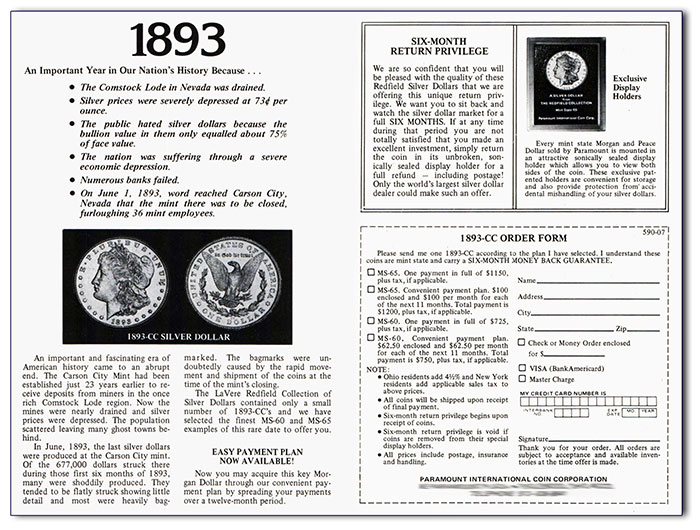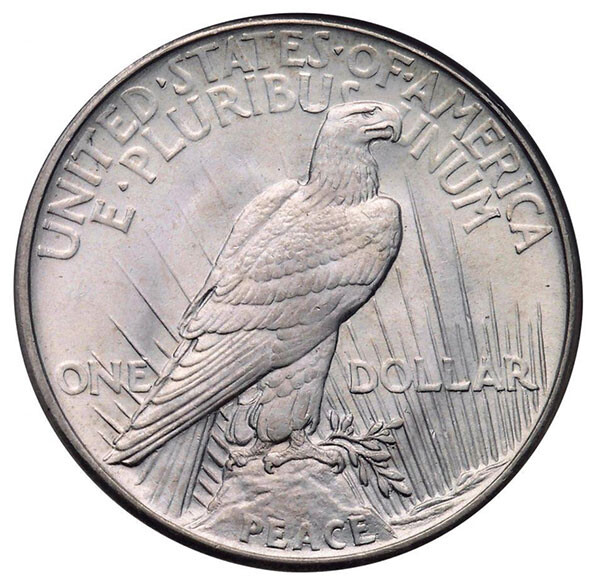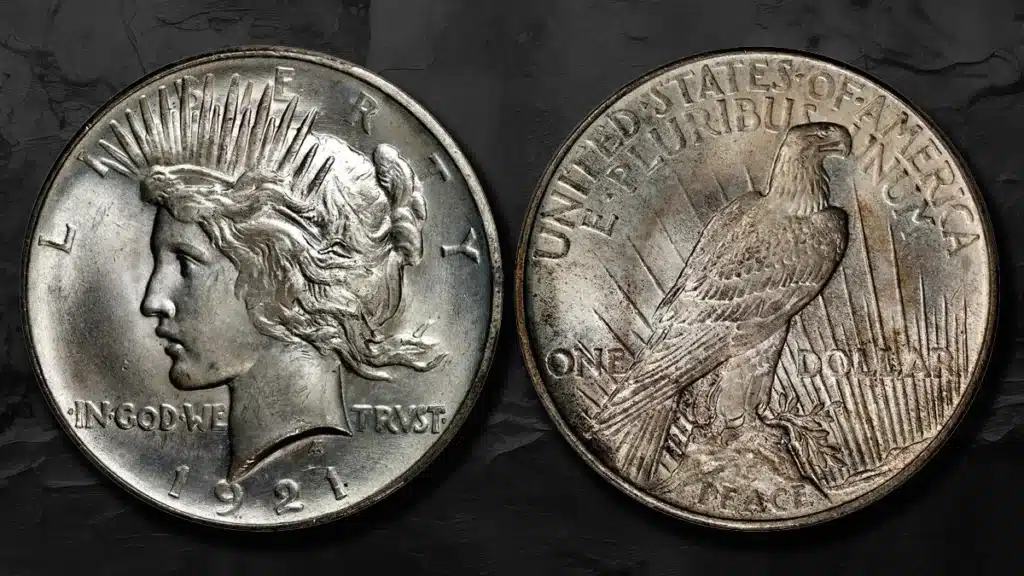
How Did the Morgan Dollar Get its Name?
The Morgan dollar gets its name from United States Mint engraver George T. Morgan, who designed the dollar coin in competition with then-Chief Engraver William Barber. The two had a generally cordial relationship, though numismatists throughout the generations have supposed that Barber may have been envious of Morgan’s talent as an engraver and treated him with some degree of unprofessionalism. This is not true.
Morgan was born in England and began working for the Mint soon after his arrival in the United States in 1876. Morgan was brought on as an assistant engraver in October 1876 and then worked under William Barber. In addition to the Liberty Head dollar, Morgan has several coin design credits to his name, including the Columbian half dollar of 1892 and 1893, and an array of pattern coins designed during the late 19th century, most notable of these being the never-released $100 Gold Union coin.
The 1893-CC Morgan Dollar Was Struck In the Final Years of the Carson City Mint
The 1893-CC Morgan dollar is the last silver coin that was struck at the Carson City branch of the United States Mint. The Mint, running out of bullion deposits from the great Comstock Lode, struck 677,000 Morgan dollars in its final year of coining operations, along with 60,000 half eagles, 14,000 eagles, and 18,402 double eagles.
The United States Mint would officially decommission the Carson City branch in 1899, leaving it open as a U.S. Assay Office until 1933. During its tenure as a coin striking facility, Carson City produced some of the most storied coins in American numismatic history. Coins struck at the Carson City Mint carry with them the allure of the Old West, of stagecoaches, cowboys, gamblers, and gunslingers. It was with this evocative imagery that the Government Services Administration (GSA) sought to market the government’s stash of Carson City dollars in the 1970s and ’80s. In that pool of coins, just one 1893-CC was found.
As far as the striking of Silver Dollars is concerned, the Carson City Mint produced coins in three distinct spurts: 1870-1873 (Seated Liberty Type), 1878-1875 (Morgan Type), and 1889-1893 (Morgan Type). As far as the Morgan dollar type is concerned, the 1893-CC is the third scarcest of the Carson City issues.
Most 1893-CC Morgan dollars wound up in the Treasury vaults with the majority of those being melted down in 1918. The sealed bags of 1893-CC dollar coins that survived the melt were paid out at the San Francisco Mint and the Washington, D.C. Cash Room.
1893-CC Morgan Dollars in the Redfield Hoard

What is likely the final dispersal of 1893-CC Morgan dollars in quantity came in 1978, When Paramount International Coin Corporation counted a small number of uncirculated examples among the 400,000 coins of the massive Redfield hoard. Accumulated in secret over the course of three decades, the hoard contained mostly uncirculated silver dollars in $1,000 mint bags. The hoard contained a number of common dates, but also counted among its number several better date Morgans, including the 1889-CC, the 1895-S, and, of course, the 1893-CC.
Unfortunately, Paramount’s handling of the Redfield Hoard left much to be desired. Many of the 1893-CC dollars were mutilated after being put through a counting machine. As a result, many coins display curvilinear scratches on the cheek and the eagle’s breast. In all likelihood, this is the quality of coin you would likely receive by purchasing an “MS60” quality coin from the April 1978 Paramount ad published in The Numismatist. Paramount also offered “MS65” coins for $1,150 (approximately $4,800 adjusted for inflation).
Assuming the quality of that coin exceeded PCGS or NGC’s standards for MS63, a buyer would have made a handsome profit off of that purchase. Recent public sales of MS63 1893-CC Morgan dollars have yielded prices in the $5,750 to $6,000 range. In MS64, the price jumps to $9,000. In MS65, the price jumps by many multiples. The record price paid for an 1893-CC is $161,000 paid for a PCGS MS66 at a Legend Morphy auction in 2013. That coin, from the Jack Lee Collection, is the PCGS plate coin for the issue.
What are 1893-CC Morgan Dollars Worth Today?
While the Carson Mint struck 677,000 1893-CC Morgan dollars, only a fraction of that mintage survive. CoinWeek estimates no more than 35,000 to 40,000 coins of this issue likely survive. NGC and PCGS combine to have graded 15,410 coins. CAC, a new grading service, reports only 17 coins in their holder as November 11, 2023. These coins were likely, once in PCGS or NGC holders. Given that it is profitable to certify even circulated 1893-CC Morgan dollars, the likelihood that there are significant numbers of coins that have yet to cycle through the grading services is low.
The value of an 1893-CC Morgan dollar depends on condition and eye appeal.
Condition relates to the amount of a wear that is imparted on a coin through circulation or mishandling. Eye appeal is a visual quality that imparts excitement on an enthusiast. When all coins are struck, they are considered to be uncirculated or in Mint State. But not all uncirculated or Mint State coins are imbued with eye appeal.
At the low end, in the most heavily circulated grades, and 1893-CC Morgan dollar is worth between $300 and $500. A circulated coin in Extra Fine condition will retain most of its design elements. At this level, 1893-CC Morgan dollars will typically sell for prices between $2,000 and $3,000. This jump in price is caused by the increased scarcity of the coin as grades approach uncirculated condition.
Coins that have never circulated will exhibit a range of features that fall in the eye appeal category. Here, the number of visible marks, the strength of the strike, the prominence of the coin’s luster, and sometimes even the color of the coin will dramatically influence the coin’s value. Uncirculated coins trade for prices approaching $10,000 for a lower-end uncirculated coin up to $200,000 or more for extraordinary examples with high eye appeal. Most uncirculated 1893-CC Morgan dollars trade between reputable coin dealers or at major auctions.
Collectors are advised to avoid purchasing any 1893-CC Morgan dollar unless it is first authenticated and certified by CAC, NGC, or PCGS. Also, purchase coins from knowledgable dealers who are authorized dealers of these three services.
Obverse:
The obverse of the 1893-CC Morgan dollar exhibits the characteristic left-facing Liberty Head motif seen on all issues of this classic dollar series. The central Liberty bust wears a Phrygian cap encircled with a ribbon adorned with the inscription LIBERTY. Miss Liberty also wears a crown of wheat and cotton, which were two of the nation’s most lucrative natural agricultural assets in the 19th century.
The phrase E PLURIBUS UNUM is inscribed along the upper half of the obverse rim, and the date 1893 is centered at the bottom of the obverse adjacent to the rim. Seven stars appear between the left side of the date and the inscription E PLURIBUS UNUM, while six stars fill the gap between the date and motto on the lower right side of the coin. In total, the 13 stars represent the 13 colonies that combined to form the original Union of the United States. At the base of Liberty’s neck is the “M” monogram representing Morgan’s initial.
Morgan designed the Liberty head bust after the likeness of Anna Willess Williams, a Philadelphia schoolteacher who modeled for the coin. Williams received significant public recognition after her face appeared on the Morgan dollar, but she rejected the attention that was heaped upon her. She refused offers for acting roles and apparently had turned down an offer for marriage following her engagement to an unknown suitor. Before dying at the age of 68 in 1926, Williams, who sat for Morgan on the sworn condition of anonymity, rebuffed her single stint as a coin design model as little more than an “incident of my youth”.
Reverse:
The reverse of the 1893-CC Morgan dollar is dominated by a heraldic eagle, its wings spread across the upper half of the coin. Between the upper tips of the eagle’s wings appears the motto IN GOD WE TRUST. The eagle clutches an olive branch in its right claw representing peace and in its left claw are three arrows symbolizing the nation’s ability to defend itself. The central eagle design is partly encircled by a laurel wreath.
Along the rim of the upper two-thirds of the reverse is the legend UNITED STATES OF AMERICA, with the tip of the eagle’s left wings, which virtually touch the coin’s rim, penetrating the space between UNITED and STATES; the right wing visually divides the words OF and AMERICA. The words ONE DOLLAR, seen at the bottom center of the reverse, are flanked by a single, six-sided star on either side of the denomination inscription. The “CC” mintmark, denoting that the coin was struck at the Carson City Mint, is located above the DO of DOLLAR.
Edge:
The edge of the 1893-CC Morgan dollar is reeded.
Designer(s):
Engraver George T. Morgan was born in Birmingham, England in 1845. He emigrated to the United States and began work as an assistant to Mint Chief Engraver William Barber and continued to produce patterns and commemoratives under the administration of Barber’s son, Charles. Morgan himself became Chief Engraver in 1917. He died in 1925.
Coin Specifications
| Country: | United States |
| Year Of Issue: | 1893 |
| Denomination: | 1 Dollar |
| Mint Mark: | CC (Carson City) |
| Mintage: | 667,000 |
| Alloy: | 90% Silver, 10% Copper |
| Weight: | 26.73 grams |
| Diameter: | 38.10 mm |
| Edge | Reeded |
| OBV Designer | George T. Morgan |
| REV Designer | George T. Morgan |
| Quality: | Business Strike |
The post 1893-CC Morgan Dollar : A Collector’s Guide appeared first on CoinWeek: Rare Coin, Currency, and Bullion News for Collectors.



 The depiction of an American bald eagle perched on a mountaintop anchors the reverse. Clutched in its claws is an olive branch symbolizing peace; notably not included in this particular depiction of the eagle is a band of arrows representing military strength, a symbol commonly seen in similar visages of the patriotic avian emblem. The rightward-facing eagle is seen at an angle partly turned away from the viewer and towards a sunrise, which symbolizes the promise of dawning peace in the world.
The depiction of an American bald eagle perched on a mountaintop anchors the reverse. Clutched in its claws is an olive branch symbolizing peace; notably not included in this particular depiction of the eagle is a band of arrows representing military strength, a symbol commonly seen in similar visages of the patriotic avian emblem. The rightward-facing eagle is seen at an angle partly turned away from the viewer and towards a sunrise, which symbolizes the promise of dawning peace in the world.